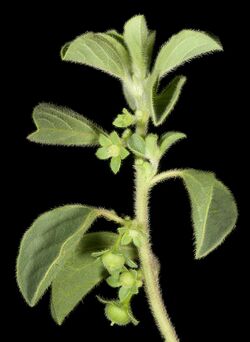Biology:Notoleptopus
| Notoleptopus | |
|---|---|

| |
| Scientific classification | |
| Kingdom: | Plantae |
| Clade: | Tracheophytes |
| Clade: | Angiosperms |
| Clade: | Eudicots |
| Clade: | Rosids |
| Order: | Malpighiales |
| Family: | Phyllanthaceae |
| Subfamily: | Phyllanthoideae |
| Tribe: | Poranthereae |
| Genus: | Notoleptopus Voronts. & Petra Hoffm. |
| Species: | N. decaisnei
|
| Binomial name | |
| Notoleptopus decaisnei (Benth.) Voronts. & Petra Hoffm.
| |
Notoleptopus is a monotypic genus of flowering plants in the family Phyllanthaceae. It is one of eight genera in the tribe Poranthereae. The sole species is Notoleptopus decaisnei. It is a monoecious shrub, native to Australia , New Guinea, and Indonesia.
Notoleptopus decaisnei had long been treated as a species of Leptopus, but in 2007, a molecular phylogenetic study of DNA sequences found it to be sister to a clade consisting of Pseudophyllanthus and Poranthera.[1] In 2008, the new genus Notoleptopus was created for it.[2]
The species, N. decaisnei, has eleven synonyms,[3] and was first described as Andrachne decaisnei by George Bentham in 1873.[4][5] The species epithet honours Joseph Decaisne.
- Andrachne decaisnei Benth.
- Andrachne decaisnei var. orbicularis Benth.
- Andrachne fruticosa Decne. ex Müll.Arg.
- Andrachne fruticosa var. orbicularis (Benth.) Pax & K.Hoffm.
- Andrachne orbicularis (Benth.) Domin
- Arachne decaisnei (Benth.) Pojark.
- Arachne fruticosa Hurus.
- Arachne orbicularis (Benth.) Pojark.
- Leptopus decaisnei (Benth.) Pojark.
- Leptopus decaisnei var. orbicularis (Benth.) Airy Shaw
- Leptopus orbicularis (Benth.) Pojark.
Description
Bentham describes the species Andrachne Decaisnei as follows:
Apparently annual, but the stems hard and woody-looking at the base, much branched, decumbent, attaining 1 to 2 or even 3 ft., the whole plant softly villous. Leaves broadly obovate or obovate-oblong, ½ to ¾ in. long, on rather long petioles. Male flowers 2 or 3 together on very short pedicels. Calyx-segments 5, lanceolate, acute, spreading, about ½ line long. Petals narrow, nearly as long as the calyx. Female flowers solitary in the same axils as the males, on pedicels attaining 1 line when in fruit. Calyx-segments under the fruit broadly ovate, fully 1 line long, the base of the calyx contracted into a distinct stipes. Styles divided to the base into 2 branches. Capsule depressed, orbicular, villous, about 2 lines diameter.[5]
In Australia, it is found in Western Australia, the Northern Territory and Queensland.[3] In Queensland, under the Nature Conservation Act 1992, it is declared a species of "least concern".[6]
References
- ↑ , Wikidata Q34189295
- ↑ , Wikidata Q43191309
- ↑ 3.0 3.1 "Notoleptopus decaisnei (Benth.) Voronts. & Petra Hoffm. | Plants of the World Online | Kew Science" (in en). http://powo.science.kew.org/taxon/urn:lsid:ipni.org:names:77090311-1.
- ↑ "Notoleptopus decaisnei". Australian Plant Name Index (APNI), IBIS database. Centre for Plant Biodiversity Research, Australian Government. https://biodiversity.org.au/nsl/services/rest/name/apni/225614.
- ↑ 5.0 5.1 Bentham, G. (23 September 1873). "Euphorbiaceae". Flora Australiensis 6: 88. https://www.biodiversitylibrary.org/page/26124620.
- ↑ The State of Queensland, Department of Environment and Science Communications (2014-10-20). "Species profile | Environment, land and water" (in en-AU). https://apps.des.qld.gov.au/species-search/details/?id=35498.
External links
Wikidata ☰ {{{from}}} entry
 |

